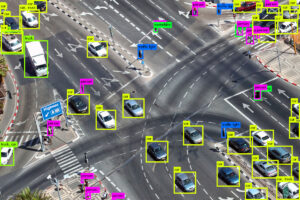
From a software perspective, license plate recognition (LPR) technology is the most commonly known and widely video analytic used for traffic management. It is used for access control, billing, travel time and security applications. However, with artificial intelligence, machine learning and deep learning all become more widely used, traffic management systems are adopting more advanced analytic functions.
For the most part, video analysis functions are mainly of real-time detection of anomalous traffic situations (e.g., vehicle stop, queue, wrong-way driver, etc.) and collection of statistical traffic data (e.g., counting, vehicle classification, average speed, distance between vehicles, etc.). In urban settings, traffic light management and parking spot occupancy are also provided as additional video analytics functions.
Advanced video analytics can be enabled on existing legacy systems with minor additions to the existing hardware ecosystem. To do this, servers capable of machine learning would need to be installed at the data center, which would house the policy-driven engine that processes the incoming video feeds and applies the rules set as per the use-cases defined by the customer requirements.
However, video analytics based on standard computer vision cannot reach its full potential when only using existing cameras whose main purpose is for video surveillance. Integrating deep learning technologies within a professional video analysis system makes it possible to make a traffic analysis system adaptive by exploiting cameras not installed for traffic analysis purpose.
Edge-based advanced video processing or centralized processing have also had a positive impact on traffic management systems. In order to minimize video streams in saturated or low-bandwidth networks, the trend has gone toward embedding processors in cameras or local systems.

Especially in urban areas, the presence mostly of distributed architectures with insufficient network coverage has encouraged onboard analysis solution in case of new supplies.
Data and measures are already moving from field to higher level systems in traffic management centers. At this time, machine learning models, trained and generated in development computers, with suitable GPU features, can be transferred to simpler local processors.
Yet, as video analysis get more complex, machine learning and deep learning are making it possible to decipher through the data. For example, machine learning is being used to optimize algorithms and cover the shortcomings of traditional techniques. Using machine learning is always preferable…as it enables the system to continuously identify patterns, learn and update itself to improve performance.
This is especially crucial the tough outdoors conditions in which traffic management systems are deployed. Machine learning assists in recognizing license plates with hidden or dirty areas, discarding regions of the image with interference, exclusion of traffic information due to shadows throughout the day, and make the information more reliable at night too. This continuous cycle of learning and updating on-site increases the prediction accuracy of the system and hence, provides better result.
Deep learning can be used for more advanced capabilities, taking advantage of human-guided training to produce recognition models that can later be generic. Intelligent cameras can then combine this with traditional sensors and complement the information with additional attributes such as in/out zones, crash risk evaluation, behavioral analysis and alerts. This can enrich mobility management systems with non-conventional data and provide opportunity to empower such systems with decision making and additional triggers for response plans.
Still one of the most important things to remember is that video traffic analysis system should not be considered a standalone system, but a part of a more complex traffic management architecture. It is not a simple interface but a deep integration with the other components (e.g., storage, network devices, VMS, SCADA, ITS platform, etc.) that must be provided and guaranteed.
Adapted from a&s Magazine



































































